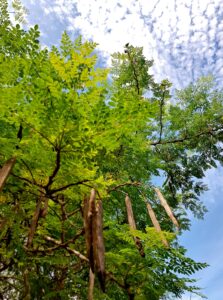Moringa Trees
In a world embracing health-conscious choices and sustainable living, the Moringa tree has emerged as a remarkable green superfood. Native to tropical and subtropical regions, this unassuming plant, often called the “Miracle Tree” or “Tree of Life,” possesses exceptional properties. Despite its delicate appearance, the Moringa tree showcases astonishing adaptability, thriving in arid conditions with roots that tap into deep groundwater sources. With its rapid growth rate, reaching up to 15 feet in a single year, it not only offers a captivating sight but also provides a sustainable source of nourishment. The Moringa leaves, packed with essential vitamins, minerals, and antioxidants, offer a wide array of nutritional benefits, from bolstering the immune system to aiding in weight management. Additionally, Moringa trees contribute to environmental sustainability, preventing soil erosion and aiding in water conservation, while actively sequestering carbon dioxide from the atmosphere.
The Moringa seeds even hold promise as a renewable bio-fuel source, further showcasing the versatility and adaptability of these remarkable trees. With culinary uses and applications in traditional medicine, the Moringa tree truly embodies the fusion of nutrition, sustainability, and global well-being. Embracing Moringa invites us to explore nature’s offerings and embrace its potential for a greener future.
A Tree Like No Other

Standing tall with delicate fern-like leaves and slender branches, the Moringa tree paints a picturesque silhouette against the sky. But don’t let its unassuming appearance fool you. This tree possesses an astonishing adaptability, thriving in arid conditions with roots that can tap into deep groundwater sources. It’s no wonder Moringa trees have become a symbol of resilience, surviving in some of the harshest environment’s nature has to offer.
As you gaze upon a Moringa tree, its elegance and grace might captivate you. The tree stands proud, reaching for the sun with its slender branches spreading like outstretched arms. Its delicate, feathery leaves dance in the breeze, casting a dappled shade on the ground beneath.
What truly sets Moringa trees apart, however, is their exceptional ability to thrive in challenging environments. These trees are like nature’s own survivors, enduring arid and dry conditions where other plants struggle to grow. With roots that possess a remarkable capacity to tap into deep groundwater sources, Moringa trees can find sustenance even in regions with limited water availability. They are masters of adaptation, making the most of what their surroundings have to offer.
Imagine the sun beating down relentlessly on a barren landscape, yet amidst the harshness, a Moringa tree stands tall, steadfast and green. Its leaves shimmer in the sunlight, reflecting a resilience that has been honed over centuries. While other plants wither and fade, Moringa trees continue to thrive, embracing the heat and turning it into life-sustaining energy.
This incredible ability to survive and flourish in diverse environments has made the Moringa tree a beloved presence in many tropical and subtropical regions.
Communities have come to rely on these trees as a dependable source of nourishment, even when faced with limited resources. Moringa’s adaptability serves as a reminder of nature’s resilience and the beauty that can emerge from the most challenging circumstances.
What’s more, Moringa trees have another remarkable characteristic that adds to their allure: their rapid growth rate. In a single year, a Moringa tree can shoot up to an astonishing 15 feet, defying conventional expectations of plant growth. This exceptional growth rate not only adds to the tree’s visual splendor but also contributes to its sustainability as a valuable resource.
The combination of adaptability and rapid growth makes Moringa trees more than just a striking addition to the natural landscape. They become a beacon of hope, a testament to the incredible ability of nature to adapt, regenerate, and provide sustenance even in the face of adversity. As we explore the wonders of the Moringa tree, we begin to understand that this is no ordinary plant, but a living testament to the resilience and beauty that exist within the natural world.
Nutritional Powerhouse

As we delve into the nutritional composition of Moringa leaves, we uncover a treasure trove of essential vitamins, minerals, and amino acids. These unassuming leaves pack a powerful punch when it comes to their nutritional profile, making the Moringa tree a true nutritional powerhouse.
First and foremost, Moringa leaves are abundant in vitamin C, known for its immune-boosting properties. Just a small serving of Moringa leaves can provide a significant portion of your daily vitamin C requirement, helping to ward off illnesses and keep your immune system strong.
But that’s not all. Moringa leaves are also rich in vitamin A, a vital nutrient for maintaining healthy vision, promoting cell growth, and supporting immune function. Vitamin A is especially crucial for the proper functioning of the eyes, and including Moringa leaves in your diet can contribute to maintaining good eye health.
When it comes to minerals, Moringa leaves are a true treasure trove. They are an excellent source of calcium, essential for building and maintaining strong bones and teeth. Calcium is not only crucial for skeletal health but also plays a vital role in muscle function, nerve transmission, and blood clotting.
Potassium, another mineral found in abundance in Moringa leaves, is essential for maintaining proper heart function, regulating blood pressure, and supporting overall cardiovascular health. Including potassium-rich foods like Moringa leaves in your diet can help promote a healthy heart and maintain optimal blood pressure levels.
Iron, a mineral vital for the production of red blood cells and oxygen transportation throughout the body, is also found in significant amounts in Moringa leaves. Iron deficiency can lead to fatigue, weakness, and impaired cognitive function, making Moringa leaves a valuable addition to combat iron-deficiency anemia.
Additionally, Moringa leaves are a surprising source of plant-based protein. Protein is an essential macro-nutrient involved in various physiological functions, including muscle repair, hormone production, and immune support. Incorporating Moringa leaves into your meals can be particularly beneficial for vegetarians, vegans, or individuals looking to increase their protein intake.
Beyond the impressive array of vitamins and minerals, Moringa leaves are rich in antioxidants, such as quercetin and chlorogenic acid. Antioxidants play a crucial role in neutralizing harmful free radicals in the body, reducing oxidative stress, and mitigating inflammation. This antioxidant content in Moringa leaves contributes to their potential health benefits, including reduced risk of chronic diseases and enhanced overall well-being.
Whether consumed fresh, cooked, or dried and powdered, Moringa leaves offer a convenient and nutrient-dense addition to your diet. Incorporating these leaves into your meals, whether in salads, soups, smoothies, or other creative recipes, can provide a substantial nutritional boost.
Environmental Sustainability of the Moringa Tree

The allure of Moringa trees extends beyond their remarkable nutritional profile. These trees actively contribute to environmental sustainability, making them valuable allies in the fight against climate change and promoting a greener future.
One of the most notable environmental benefits of Moringa trees is their ability to prevent soil erosion. With their extensive root systems, they anchor the soil, helping to combat the erosion caused by wind and water. This is especially crucial in regions prone to drought or heavy rainfall, where soil erosion can lead to land degradation and reduced agricultural productivity. Moringa trees act as guardians of the soil, preserving its integrity and fertility.
Furthermore, the dense foliage of Moringa trees plays a vital role in water conservation. The leaves provide shade, reducing evaporation and helping to retain moisture in the soil. This can be particularly valuable in arid and semi-arid regions where water scarcity is a pressing issue. By conserving water, Moringa trees support the sustainable use of this precious resource and contribute to the overall health of ecosystems.
Carbon sequestration is another significant environmental benefit offered by Moringa trees. These trees actively absorb carbon dioxide (CO2) from the atmosphere during photosynthesis, helping to mitigate the impacts of greenhouse gas emissions. As concerns about climate change intensify, the role of carbon sequestration in offsetting CO2 emissions becomes increasingly crucial. Moringa trees, with their rapid growth and ability to sequester significant amounts of carbon, become essential allies in combating global warming.
| Attribute | Information |
|---|---|
| Common Name | Moringa plant, moringa tree, miracle tree, horseradish tree, drumstick tree, ben oil tree |
| Botanical Name | Moringa oleifera |
| Family | Moringaceae |
| Plant Type | Tree |
| Mature Size | 25-35 ft. tall, 15-25 ft. wide |
| Sun Exposure | Full |
| Soil Type | Loamy, sandy, well-drained |
| Soil pH | Neutral, acidic |
| Bloom Time | Spring |
| Flower Color | White |
| Hardiness Zones | 10-11 (USDA) |
| Native Area | Asia |
Moreover, Moringa trees exhibit a remarkable adaptability to challenging environments. They can thrive in regions with limited water availability and in poor-quality soils, reducing the need for extensive irrigation or fertilizers. By growing and flourishing in these conditions, Moringa trees offer a sustainable solution to land use challenges and contribute to the conservation of natural resources.
Another notable aspect of Moringa trees is the potential for their seeds to serve as a renewable bio-fuel source. The oil extracted from Moringa seeds is of high quality and can be converted into biodiesel. This presents an environmentally friendly alternative to fossil fuels, reducing reliance on non-renewable resources and minimizing carbon emissions. By harnessing the energy potential of Moringa seeds, we can take a significant step towards a more sustainable and clean energy future.
In summary, Moringa trees are not only nutritional powerhouses but also champions of environmental sustainability. Their ability to prevent soil erosion, conserve water, sequester carbon, and thrive in challenging conditions make them valuable assets in addressing pressing environmental issues. The benefits extend beyond their immediate surroundings, contributing to the larger goals of mitigating climate change, conserving natural resources, and promoting a greener planet.
Culinary and Practical Applications

The wonders of Moringa trees extend beyond their nutritional benefits and environmental contributions. These versatile trees have gained recognition for their diverse culinary and practical applications, showcasing their ability to enhance our meals and everyday lives.
In the culinary world, Moringa leaves have made a remarkable impact. Their unique flavor adds a delightful twist to various dishes, making them a sought-after ingredient. Whether consumed fresh or dried, Moringa leaves bring a vibrant, earthy taste to salads, stir-fries, and soups. Their versatility allows them to be incorporated into an array of recipes, from hearty mains to refreshing beverages.
For those seeking a nutritious boost, Moringa leaves can be transformed into a nourishing tea. By steeping the leaves in hot water, you can create a fragrant, herbal infusion that not only offers a pleasant taste but also provides a dose of vitamins and antioxidants. Moringa tea has become a popular choice for those looking to reap the health benefits of this incredible tree in a comforting and soothing form.
Another creative use of Moringa is in the form of powder. By drying and grinding the leaves, we obtain a vibrant green powder that can be sprinkled onto various dishes, adding a touch of flavor and nutrition. Moringa powder has become a staple ingredient in smoothies, giving them a nutritional boost and a vibrant green hue. It can also be used as a seasoning, adding a distinctive taste to sauces, dips, and even baked goods.
Beyond the realm of culinary delights, Moringa trees have found practical applications in traditional medicine. For centuries, different parts of the Moringa tree have been utilized to address a variety of ailments. The leaves, roots, seeds, and even the bark contain compounds that possess therapeutic properties.
In traditional medicine, Moringa has been used to treat conditions such as anemia, arthritis, and diabetes. The leaves, rich in iron, have been traditionally employed to alleviate symptoms of iron deficiency and support healthy blood production. The anti-inflammatory properties of Moringa leaves and bark have been utilized to soothe joint pain and reduce inflammation associated with arthritis. Furthermore, experts recognize the potential of Moringa seeds to regulate blood sugar levels, positioning them as a natural remedy for managing diabetes.

The practical applications of Moringa trees extend beyond health-related uses. In some regions, people actively utilize the wood of the Moringa tree for construction, effectively harnessing a sustainable and renewable source of timber. Moringa showcases its versatility and resourcefulness by actively transforming the fibrous inner bark into ropes or skillfully weaving it into baskets.
The Moringa tree truly embodies the concept of “Tree of Life” by providing nourishment, flavor, and practical solutions to various aspects of our lives. Whether enjoyed in culinary creations, brewed as tea, utilized in traditional medicine, or employed for practical purposes, Moringa demonstrates its adaptability and value across different domains.
As we continue our exploration of the wonders of Moringa, this extraordinary tree serves as a constant reminder of the countless ways it can enrich our daily lives. Whether it’s adding a touch of flavor to our meals, offering natural remedies for ailments, or providing sustainable resources, Moringa trees beckon us to embrace their gifts and unlock their full potential.
As we reach the conclusion of our journey through the remarkable qualities of the Moringa tree, we find ourselves deeply appreciating its role as a green superfood, an ally in environmental preservation, and a versatile companion in our culinary and practical pursuits. The Moringa tree invites us to embrace its offerings, supporting sustainable living and nurturing a deeper connection with nature.

Conclusion
In the enchanting world of Moringa trees, we have uncovered a true marvel—a green superfood that tantalizes our taste buds, nourishes our bodies, and uplifts our spirits. From its exceptional adaptability to its rapid growth, Moringa trees stand as symbols of resilience, reminding us of nature’s ability to thrive even in the harshest conditions.
Delving into the nutritional composition of Moringa leaves, we have discovered a treasure trove of essential vitamins, minerals, and antioxidants that can invigorate our health and well-being. From strengthening our immune systems to supporting healthy bones and reducing inflammation, Moringa’s nutritional prowess is truly awe-inspiring.
Yet, the beauty of Moringa trees extends beyond their remarkable nutritional profile. These trees become environmental champions, actively contributing to sustainability and the fight against climate change. By preventing soil erosion, conserving water, and sequestering carbon dioxide, Moringa trees showcase their vital role in preserving the health of our planet and ensuring a greener future for generations to come.
Moreover, Moringa’s versatility knows no bounds. From culinary applications that infuse our meals with unique flavors and nutrition to traditional medicine that harnesses the healing properties of its leaves, roots, and seeds, Moringa has woven its way into the fabric of our lives. With each sip of Moringa tea or sprinkle of Moringa powder, we embrace the nourishing benefits of this extraordinary tree.
As we bid farewell to the world of Moringa trees, let us carry their wisdom and gifts with us. Whether we choose to incorporate Moringa into our diets, support initiatives promoting its cultivation, or simply marvel at its ecological value, the Moringa tree invites us to honor the intricate connection between nature and our well-being.
Let us remember that in a world seeking sustainable solutions, the Moringa tree stands tall, a testament to the resilience of nature and the power of embracing its offerings. With every bite, sip, and act of preservation, we celebrate the wonders of Moringa and the countless ways it enhances our lives.
So, let us venture forth, nourished by the knowledge and appreciation for Moringa’s virtues, and together, may we continue to explore the beauty of nature’s gifts, striving for a harmonious existence with the world around us. The Moringa tree awaits, ready to share its wonders and guide us towards a brighter, greener future.
References
https://www.medicalnewstoday.com/articles/319916
https://www.webmd.com/vitamins/ai/ingredientmono-1242/moringa
Moringa With Barry stores offer a variety of moringa products. These include: Moringa Powder, Moringa Tea, Moringa Capsules and Moringa Oil.

